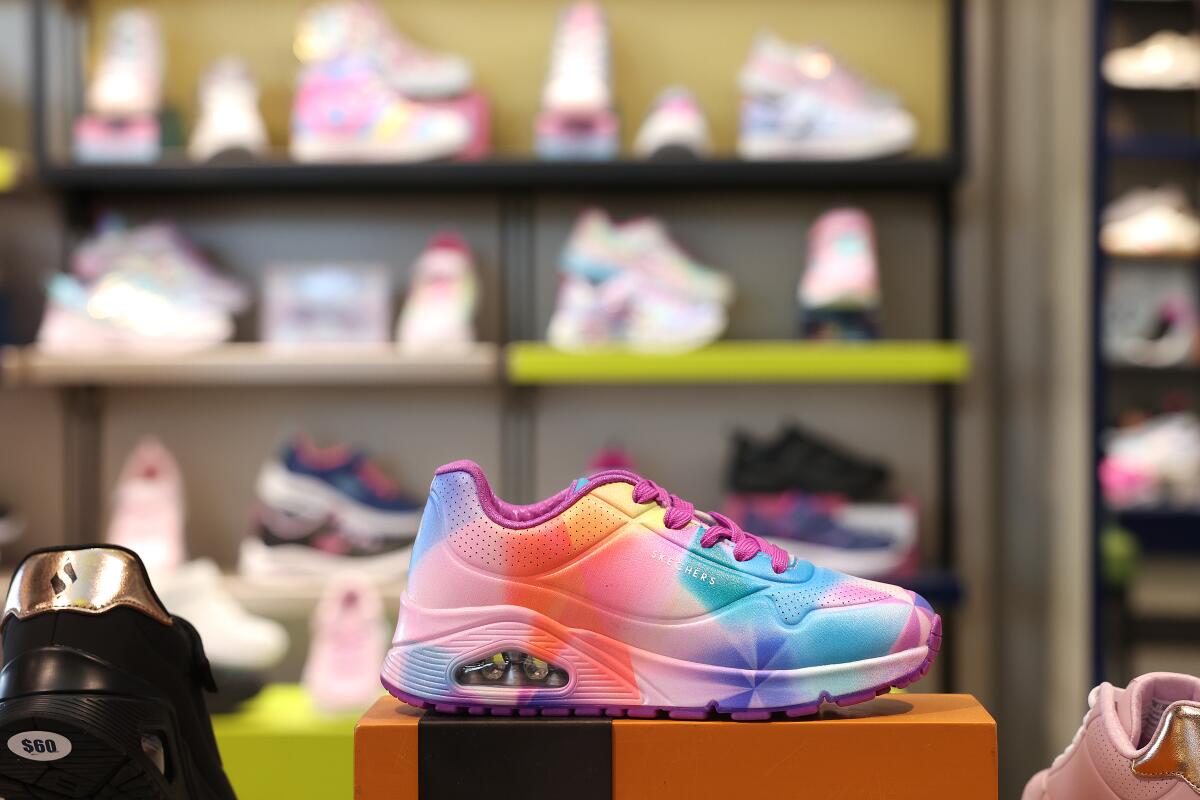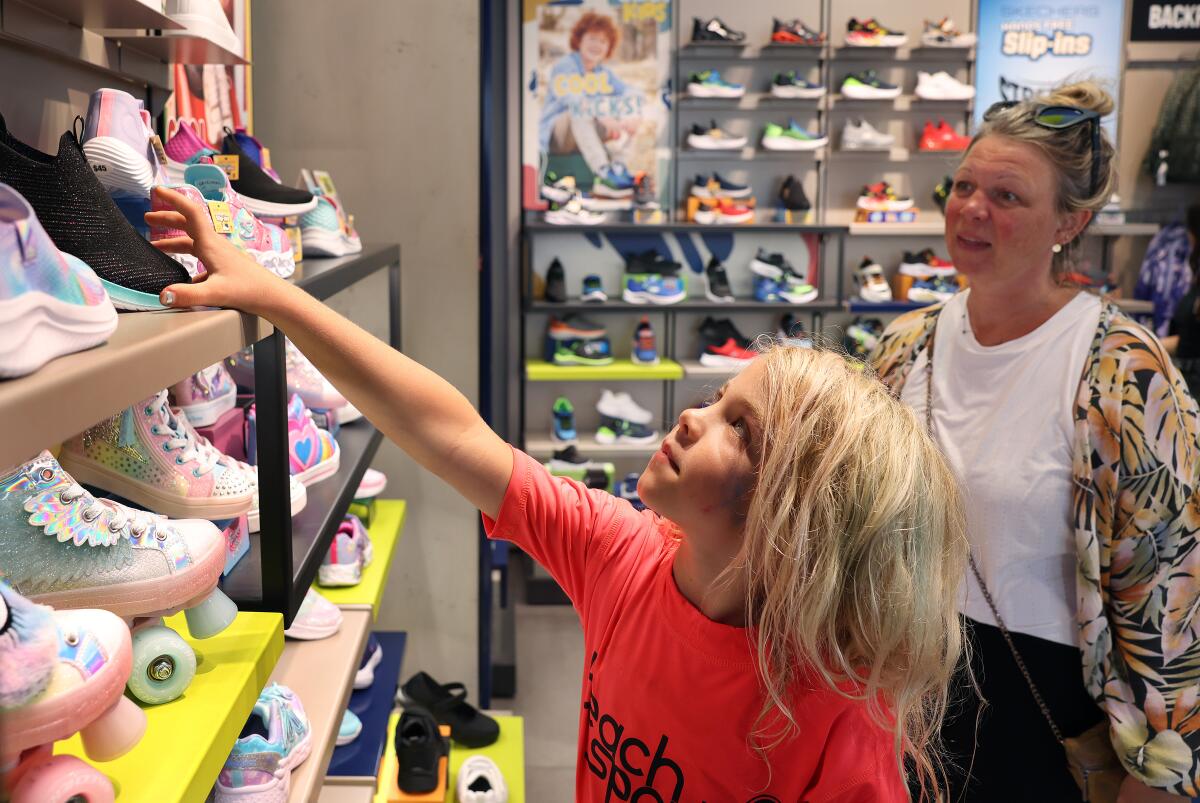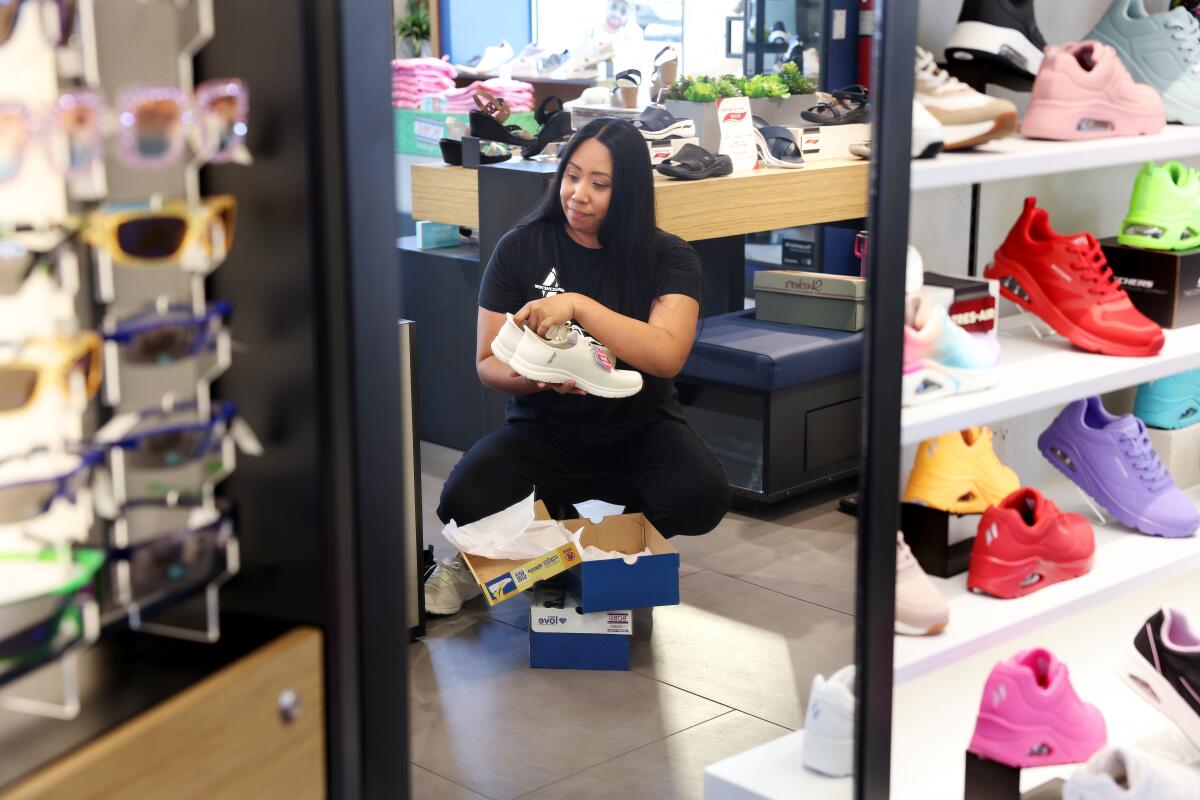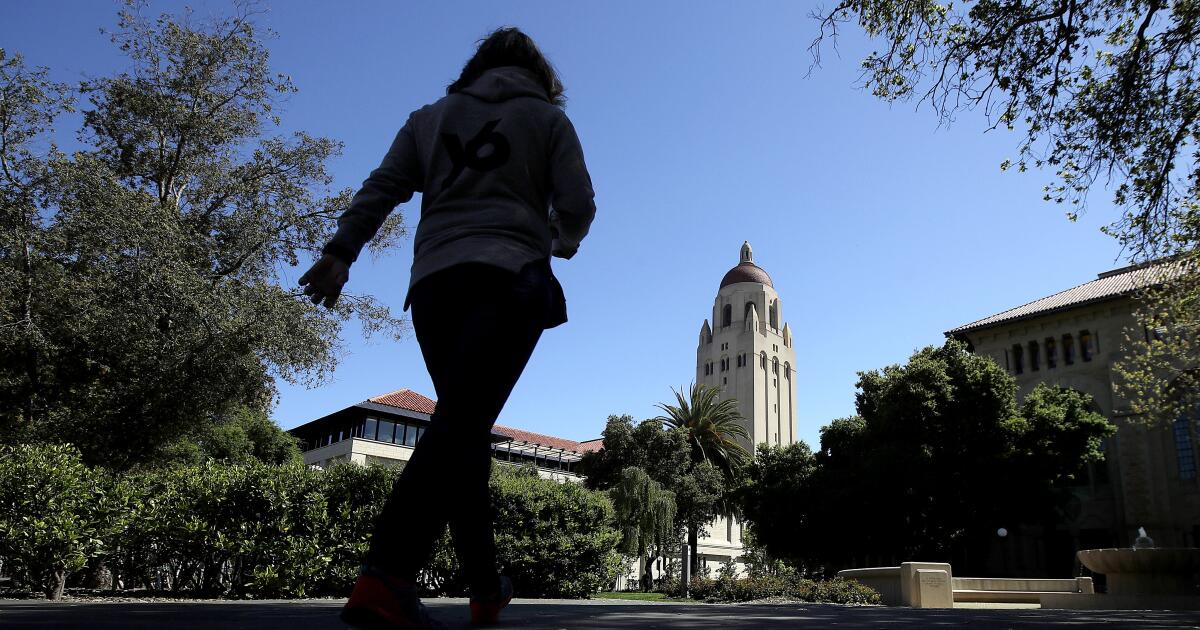Business
As competitors falter, SoCal's Skechers is surging with strategy of 'try and try again'

In a crowded sneaker market roiled by the stumbles of its longtime king, Manhattan Beach-based Skechers has been climbing its way up the ranks.
While Nike, which has dominated the athletic footwear landscape for years, made headlines last month for its plummeting stock price and gloomy outlook, Skechers announced record sales in the first quarter of 2024 of $2.25 billion, a 12.5% increase over last year. Since 2019, it has increased its annual revenue by more than 50%.
In June, Bank of America upgraded its rating on Skechers’ stock to a strong buy, and this week Morgan Stanley followed suit — notable votes of confidence in the fundamentals of a company that has seen its stock price rise more than 20% over the last year. Shares closed at $65.10 on Tuesday.
Analysts and company leadership attribute the brand’s success to a strategy built around constant innovation and a diverse array of footwear products. Sam Poser, a footwear and apparel analyst at Williams Trading, said Skechers is navigating choppy waters better than its rivals.
“It’s not like the macro environment is different for Skechers than it is for Nike or New Balance or Adidas,” Poser said. “One of the reasons they’re outperforming is because they’re executing in this difficult environment.”
While Skechers offers a wide variety of footwear — from soccer cleats to work boots to summer sandals — it has still managed to find a strong company identity, Poser said.
1
2

3

1. Skechers and Snoop Dogg collaborated on shoes. 2. Skechers offers a wide variety of footwear — soccer cleats, work boots, summer sandals and more. 3. Children’s shoes on display at the Skechers store in Manhattan Beach. (Christina House / Los Angeles Times)
“Skechers owns the comfort business,” Poser said. “What they’re doing is bigger than I think a lot of people appreciate.”
Skechers brought in $8 billion in sales in 2023 compared with $7.4 billion in 2022. The company has a near-term goal of reaching $10 billion in sales by 2026, said Chief Financial Officer John Vandemore.
The self-proclaimed “comfort technology company” has seen success with recent releases such as Hands Free Slip-ins and podiatrist-certified Arch Fit shoes. Its website lists 14 different footwear technologies, with names like Glide-Step and Hyper Burst.
“You have to be innovative and you have to deliver newness,” Vandemore said in an interview. “There was no analogy in the marketplace when we started Slip-ins, and it’s done exceedingly well.”
The company is scheduled to announce its second-quarter results on Thursday, with analysts estimating revenue of $2.21 billion, up 10% from the same period a year ago, and earnings of 92 cents a share, down 6.1% from a year earlier, according to Zacks Equity Research.
Not all of Skechers’ gambles have paid off, Vandemore acknowledged. Introduced in 2009, Shape-up sneakers were immensely popular until the company was sued by the Federal Trade Commission over its claims that the shoes would help customers lose weight and tone their muscles. Skechers paid $40 million to settle the class-action lawsuit in 2013.
Other Skechers models have seen longer-term success, such as the children’s line of light-up Twinkle Toes sneakers, introduced in 2008 and still widely available.

Caleigh Hopson, 7, browses shoes with her mother, Laura, at the Skechers store in Manhattan Beach.
(Christina House / Los Angeles Times)
“I think that willingness to try and try again until you succeed is noteworthy and it’s led to a significant amount of success,” Vandemore said. He praised the company’s chief executive, Robert Greenberg, for his willingness to take risks.
“One of Robert’s key talents is being able to tolerate risks and, quite frankly, not dwell upon them,” Vandemore said. “In our culture we try a lot of different things. Some of them work and some of them don’t.”
In contrast, Poser said, Nike has not been able to come up with fresh offerings for consumers in recent years.
“Nike was not innovating enough and putting a lot of non-compelling product into the marketplace,” he said.
When Nike released its tepid first-quarter earnings report in March, its chief financial officer, Matthew Friend, said the company was “taking action to build a faster, more efficient Nike and maximize the impact of our new innovation cycle.”
Along with a pipeline of new products, Vandemore said, value and affordability are among the brand’s top priorities. Several models featuring the popular Slip-in technology are available for less than $100.
“They’re delivering a quality product that has comfort and style at a reasonable price,” said Jim Duffy, a sports and lifestyle analyst at Stifel. “In an environment where the consumer is facing pressures to their discretionary spending capacity, Skechers is doing a very good job of offering value.”
In a trend brought on by COVID-19, Duffy said, more consumers of all income levels are buying and wearing athletic footwear. A nice dinner out may have required dress shoes before the global pandemic, he said, but standards have changed.
“COVID was an accelerator for casualization and that’s really expanded the wearable occasions for sneakers and comfort footwear,” Duffy said. “Skechers has done well to capitalize on that.”
Skechers’ customer base is mostly children and older adults, Duffy said, not teens and young adults. But Poser said the customer demographic varies largely across markets, both in the U.S. and internationally.
“It’s much broader than you think,” Poser said. “They have K-pop bands wearing their shoes.”
Last year, international sales accounted for 62% of the company’s global revenue. Vandemore said Skechers’ investment in growing its international footprint has provided the company an important boost in growth.

Store manager Diane Morales unboxes a pair of shoes for a customer at the Skechers store in Manhattan Beach.
(Christina House / Los Angeles Times)
At the end of March, the company had slightly more than 1,100 international stores, 565 domestic locations and more than 3,500 “distributor, licensee and franchise stores,” according to company figures. The corporate offices in Manhattan Beach house 1,280 employees.
Vandemore also said the company’s balance of wholesale and direct-to-consumer sales set it apart from other brands in the industry.
“Some of our competitors have chosen to primarily focus on their own stores or their own online sales at the expense of wholesale partners, which is not our strategy,” Vandemore said. “We embrace all avenues.”
In 2023, 44% of Skechers’ annual profits came from direct-to-consumer sales and 56% came from wholesale business.
Looking to the future, Vandemore said Skechers will stick to its core strategy while adapting to new trends and demands.
“We’ve been very successful focusing on developing and delivering great products, growing our direct-to-consumer channel and growing internationally,” he said. “That formula, we do believe, will continue to yield results.”

Business
U.S. Space Force awards $1.6 billion in contracts to South Bay satellite builders

The U.S. Space Force announced Friday it has awarded satellite contracts with a combined value of about $1.6 billion to Rocket Lab in Long Beach and to the Redondo Beach Space Park campus of Northrop Grumman.
The contracts by the Space Development Agency will fund the construction by each company of 18 satellites for a network in development that will provide warning of advanced threats such as hypersonic missiles.
Northrop Grumman has been awarded contracts for prior phases of the Proliferated Warfighter Space Architecture, a planned network of missile defense and communications satellites in low Earth orbit.
The contract announced Friday is valued at $764 million, and the company is now set to deliver a total of 150 satellites for the network.
The $805-million contract awarded to Rocket Lab is its largest to date. It had previously been awarded a $515 million contract to deliver 18 communications satellites for the network.
Founded in 2006 in New Zealand, the company builds satellites and provides small-satellite launch services for commercial and government customers with its Electron rocket. It moved to Long Beach in 2020 from Huntington Beach and is developing a larger rocket.
“This is more than just a contract. It’s a resounding affirmation of our evolution from simply a trusted launch provider to a leading vertically integrated space prime contractor,” said Rocket Labs founder and chief executive Peter Beck in online remarks.
The company said it could eventually earn up to $1 billion due to the contract by supplying components to other builders of the satellite network.
Also awarded contracts announced Friday were a Lockheed Martin group in Sunnyvalle, Calif., and L3Harris Technologies of Fort Wayne, Ind. Those contracts for 36 satellites were valued at nearly $2 billion.
Gurpartap “GP” Sandhoo, acting director of the Space Development Agency, said the contracts awarded “will achieve near-continuous global coverage for missile warning and tracking” in addition to other capabilities.
Northrop Grumman said the missiles are being built to respond to the rise of hypersonic missiles, which maneuver in flight and require infrared tracking and speedy data transmission to protect U.S. troops.
Beck said that the contracts reflects Rocket Labs growth into an “industry disruptor” and growing space prime contractor.
Business
California-based company recalls thousands of cases of salad dressing over ‘foreign objects’

A California food manufacturer is recalling thousands of cases of salad dressing distributed to major retailers over potential contamination from “foreign objects.”
The company, Irvine-based Ventura Foods, recalled 3,556 cases of the dressing that could be contaminated by “black plastic planting material” in the granulated onion used, according to an alert issued by the U.S. Food and Drug Administration.
Ventura Foods voluntarily initiated the recall of the product, which was sold at Costco, Publix and several other retailers across 27 states, according to the FDA.
None of the 42 locations where the product was sold were in California.
Ventura Foods said it issued the recall after one of its ingredient suppliers recalled a batch of onion granules that the company had used n some of its dressings.
“Upon receiving notice of the supplier’s recall, we acted with urgency to remove all potentially impacted product from the marketplace. This includes urging our customers, their distributors and retailers to review their inventory, segregate and stop the further sale and distribution of any products subject to the recall,” said company spokesperson Eniko Bolivar-Murphy in an emailed statement. “The safety of our products is and will always be our top priority.”
The FDA issued its initial recall alert in early November. Costco also alerted customers at that time, noting that customers could return the products to stores for a full refund. The affected products had sell-by dates between Oct. 17 and Nov. 9.
The company recalled the following types of salad dressing:
- Creamy Poblano Avocado Ranch Dressing and Dip
- Ventura Caesar Dressing
- Pepper Mill Regal Caesar Dressing
- Pepper Mill Creamy Caesar Dressing
- Caesar Dressing served at Costco Service Deli
- Caesar Dressing served at Costco Food Court
- Hidden Valley, Buttermilk Ranch
Business
They graduated from Stanford. Due to AI, they can’t find a job

A Stanford software engineering degree used to be a golden ticket. Artificial intelligence has devalued it to bronze, recent graduates say.
The elite students are shocked by the lack of job offers as they finish studies at what is often ranked as the top university in America.
When they were freshmen, ChatGPT hadn’t yet been released upon the world. Today, AI can code better than most humans.
Top tech companies just don’t need as many fresh graduates.
“Stanford computer science graduates are struggling to find entry-level jobs” with the most prominent tech brands, said Jan Liphardt, associate professor of bioengineering at Stanford University. “I think that’s crazy.”
While the rapidly advancing coding capabilities of generative AI have made experienced engineers more productive, they have also hobbled the job prospects of early-career software engineers.
Stanford students describe a suddenly skewed job market, where just a small slice of graduates — those considered “cracked engineers” who already have thick resumes building products and doing research — are getting the few good jobs, leaving everyone else to fight for scraps.
“There’s definitely a very dreary mood on campus,” said a recent computer science graduate who asked not to be named so they could speak freely. “People [who are] job hunting are very stressed out, and it’s very hard for them to actually secure jobs.”
The shake-up is being felt across California colleges, including UC Berkeley, USC and others. The job search has been even tougher for those with less prestigious degrees.
Eylul Akgul graduated last year with a degree in computer science from Loyola Marymount University. She wasn’t getting offers, so she went home to Turkey and got some experience at a startup. In May, she returned to the U.S., and still, she was “ghosted” by hundreds of employers.
“The industry for programmers is getting very oversaturated,” Akgul said.
The engineers’ most significant competitor is getting stronger by the day. When ChatGPT launched in 2022, it could only code for 30 seconds at a time. Today’s AI agents can code for hours, and do basic programming faster with fewer mistakes.
Data suggests that even though AI startups like OpenAI and Anthropic are hiring many people, it is not offsetting the decline in hiring elsewhere. Employment for specific groups, such as early-career software developers between the ages of 22 and 25 has declined by nearly 20% from its peak in late 2022, according to a Stanford study.
It wasn’t just software engineers, but also customer service and accounting jobs that were highly exposed to competition from AI. The Stanford study estimated that entry-level hiring for AI-exposed jobs declined 13% relative to less-exposed jobs such as nursing.
In the Los Angeles region, another study estimated that close to 200,000 jobs are exposed. Around 40% of tasks done by call center workers, editors and personal finance experts could be automated and done by AI, according to an AI Exposure Index curated by resume builder MyPerfectResume.
Many tech startups and titans have not been shy about broadcasting that they are cutting back on hiring plans as AI allows them to do more programming with fewer people.
Anthropic Chief Executive Dario Amodei said that 70% to 90% of the code for some products at his company is written by his company’s AI, called Claude. In May, he predicted that AI’s capabilities will increase until close to 50% of all entry-level white-collar jobs might be wiped out in five years.
A common sentiment from hiring managers is that where they previously needed ten engineers, they now only need “two skilled engineers and one of these LLM-based agents,” which can be just as productive, said Nenad Medvidović, a computer science professor at the University of Southern California.
“We don’t need the junior developers anymore,” said Amr Awadallah, CEO of Vectara, a Palo Alto-based AI startup. “The AI now can code better than the average junior developer that comes out of the best schools out there.”
To be sure, AI is still a long way from causing the extinction of software engineers. As AI handles structured, repetitive tasks, human engineers’ jobs are shifting toward oversight.
Today’s AIs are powerful but “jagged,” meaning they can excel at certain math problems yet still fail basic logic tests and aren’t consistent. One study found that AI tools made experienced developers 19% slower at work, as they spent more time reviewing code and fixing errors.
Students should focus on learning how to manage and check the work of AI as well as getting experience working with it, said John David N. Dionisio, a computer science professor at LMU.
Stanford students say they are arriving at the job market and finding a split in the road; capable AI engineers can find jobs, but basic, old-school computer science jobs are disappearing.
As they hit this surprise speed bump, some students are lowering their standards and joining companies they wouldn’t have considered before. Some are creating their own startups. A large group of frustrated grads are deciding to continue their studies to beef up their resumes and add more skills needed to compete with AI.
“If you look at the enrollment numbers in the past two years, they’ve skyrocketed for people wanting to do a fifth-year master’s,” the Stanford graduate said. “It’s a whole other year, a whole other cycle to do recruiting. I would say, half of my friends are still on campus doing their fifth-year master’s.”
After four months of searching, LMU graduate Akgul finally landed a technical lead job at a software consultancy in Los Angeles. At her new job, she uses AI coding tools, but she feels like she has to do the work of three developers.
Universities and students will have to rethink their curricula and majors to ensure that their four years of study prepare them for a world with AI.
“That’s been a dramatic reversal from three years ago, when all of my undergraduate mentees found great jobs at the companies around us,” Stanford’s Liphardt said. “That has changed.”
-

 Iowa6 days ago
Iowa6 days agoAddy Brown motivated to step up in Audi Crooks’ absence vs. UNI
-

 Iowa1 week ago
Iowa1 week agoHow much snow did Iowa get? See Iowa’s latest snowfall totals
-

 Maine4 days ago
Maine4 days agoElementary-aged student killed in school bus crash in southern Maine
-

 Maryland6 days ago
Maryland6 days agoFrigid temperatures to start the week in Maryland
-

 Technology1 week ago
Technology1 week agoThe Game Awards are losing their luster
-

 South Dakota6 days ago
South Dakota6 days agoNature: Snow in South Dakota
-

 New Mexico4 days ago
New Mexico4 days agoFamily clarifies why they believe missing New Mexico man is dead
-

 Nebraska1 week ago
Nebraska1 week agoNebraska lands commitment from DL Jayden Travers adding to early Top 5 recruiting class




















